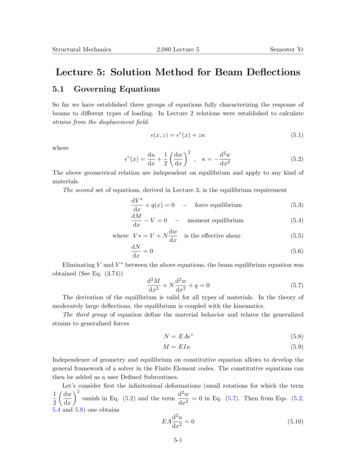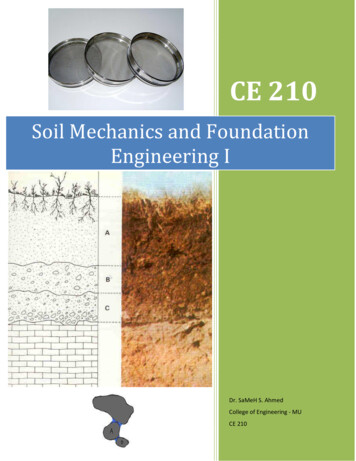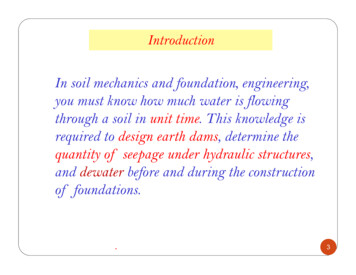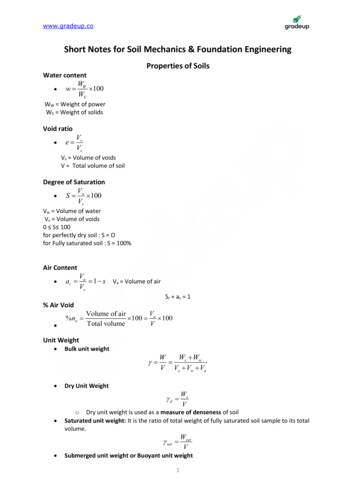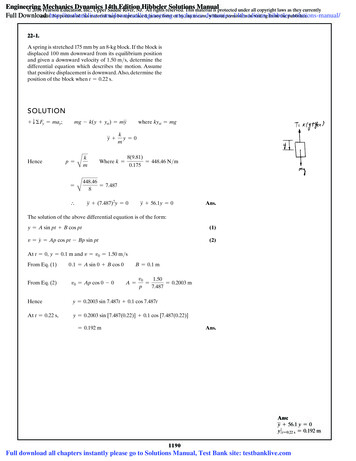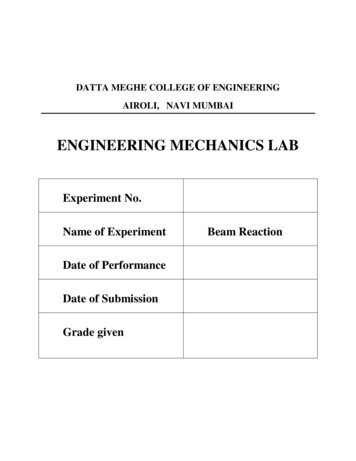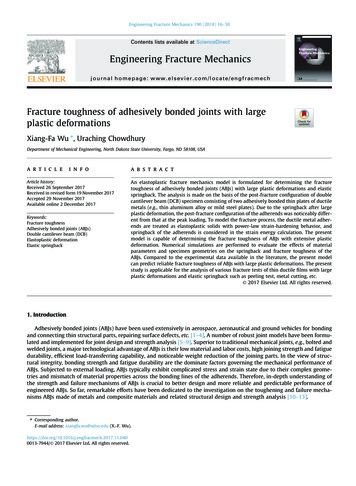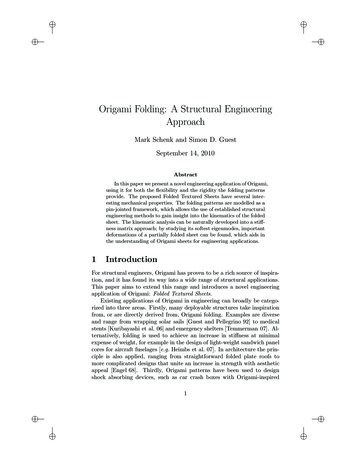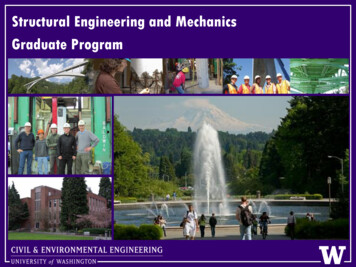
Transcription
Structural Engineering and MechanicsGraduate Program
Program Overview OverviewResearchFacilitiesDegree ProgramsCoursesTA opportunities
College of EngineeringAERONAUTICS ANDASTRONAUTICSBIOENGINEERINGCHEMICAL ENGINEERINGCIVIL ANDENVIRONMENTALENGINEERINGCOMPUTER SCIENCE ANDENGINEERINGELECTRICALENGINEERINGHUMAN CENTEREDDESIGN ANDENGINEERINGINDUSTRIAL ANDSYSTEMS ENGINEERINGMATERIALS SCIENCE ANDENGINEERINGMECHANICALENGINEERING
Civil & Environmental EngineeringWithin our department, we have six areas of study108 eotechnicalHydrology &HydrodynamicsStructuresTransportation7 Construction14 Environmental7 Geotech15 H&H38 Structures28Transportation
Structural Engineering and Mechanics auraLowesPeterMackenzieSteel StructuresStructural ControlConcrete StructuresForensic AnalysisConcrete StructuresEarthquake EngineeringConcrete StructuresPerformance-BasedSeismic DesignConstitutive TheoryNumerical ModelingStructural StabilityNumerical onRichardWiebeSolid ction ProbabilisticDesignSteel and CompositeStructuresSeismic DesignConcrete StructuresSeismic IsolationNonlinear DynamicsExperimental Mechanics
Close ationalGeomechanicsBio-mediated SoilImprovementGoetechnical Eq.EngineeringSoil LiquefactionPaleoseismologyEngineering ring andEnergyTransportation andConstructionTransportationInfrastructure andSustainabilityWind EngineeringResilient InfrastructureConstructionand SystemsEngineering
Research Research projects expected to hire students in the nearfuture are listed in the following slides. It is expected that additional projects may be added inthe future.
Impacts of Cascadia Subduction Zone M9 EarthquakeFaculty: Eberhard, Berman,Maurer (geo), Kramer (geo)Funding: NSF, WSDOT, USGSObjectives: What will CSZ M9 doto Infrastructure?- Bridges, soil types, locationApproach:- Analyses of systems to getdemands on components- Tests to determine componentcapacitiesStudents: Currently 1 graduatestudent and 1 post-doc. Will need1-3 more
New Structural System for VESTitle: Vertical EvacuationStructures Subjected to SequentialEarthquake and Tsunami Loadings.Lehman, Roeder & Motley. NSFResearch Objectives & ResearchApproach: Develop new system forearthquake and tsunami resistantstructures. Testing of new slab-CFTcolumn systems in UW structureslab. Testing of wall and new CFTs inOSU lab. Simulation of structuresincluding structure-fluidinteraction using OpenSees &OpenFoamStudents: Currently 3 graduatestudents. Hiring another 2students in AY 2019-2020.New Structural SystemSimulation of Structure in Flume
3D Printing of Fiber-Reinforced ConcreteFaculty: Lehman and Ganter (ME)Funding: Pactrans (NSF pending)Objectives & Approach:Investigate the fresh-state and hardenedengineering properties of fiber reinforcedcementitious material (FRCM) components usingextrusion-based 3D printing. Design and fabricate material extrusion-based3D printer for construction of FRCMcomponents. Develop a quality control protocol to investigatevoids and fiber alignment of 3D printed FRCMcomponents using x-ray tomography Investigate fresh-state & properties of 3DPFRCMsStudents: Currently 1 ME graduate students.Possibly hiring 1 students in AY 2019-2020.New Concrete Printer
Chevron Concentrically Braced Frameswith Yielding BeamsFaculty: Lehman, Berman & Roeder Funding: AISCResearch Objectives & Approach: Permit yielding in chevron braced frames. Experimentally investigate the seismic response of allowing yielding of beams tooptimize size. One-story and three-story frames tested with different beam sizes Use finite element analyses to investigate untested parameters Investigate dynamic response of 3, 6 and 9 story provisionsStudents: Possibly hiring 1 student in AY 2019-2020.
Investigation of Hollow PSC Pile-columnsFaculty: Stanton and Calvi.Funding Agency: WSDOT.Problem: Hollow prestressed concretecolumns, built in the 1960s are vulnerable toearthquakes by spalling internally.Goal: Investigate behavior and design aretrofit concept, using experimental andcomputational methods.Methods: Create a ductile fuse in the columndirectly below the cross-beam. Use it toreduce the forces elsewhere to a tolerablelevel. Test the fuse. Use computer models toinvestigate forces in other parts of thestructure.Students: Currently 2 CEE graduate students.Possibly hiring 1 student in AY 2019-2020.Pile-column under test
High Speed Rail in Seismic RegionsFaculty: Stanton and Eberhard.Funding Agency: FIU ABC Center, PEER.Problem: High Speed Rail imposes stringentdemands, seismic and otherwise.Goal: Investigate existing HSR raisedstructures, develop high-performancestructural systems for seismic regions.Methods: Discussions with HSR authorities,designers, contractors, literature review toestablish current methods. Design andcomputational modeling to investigateperformance of new structural systems.Students: Currently 1 CEE graduate student.Possibly hiring 1 student in AY 2019-2020.HSR – Raised Structure
Ultra-High-Performance Concrete – Shear StrengthFaculty: Calvi and Stanton.Funding Agency: FIU ABC Center.Problem: Shear behavior of UHPCis unknown.Goal: Investigate behavior of UHPCin shear and other combined stressstates. Develop preliminaryconstitutive model.Methods: Use UW “Panel tester”, developedby Calvi, to impose biaxial load states. Usemeasured responses to characterize materialconstitutive behavior.Students: Project just starting. Likely hiring 1student in AY 2019-2020.UW Panel tester
Local Effects & Global Structural Dynamics in Extreme EnvironmentsFaculty: WiebeFunding Agency: AFOSR.Problem: We need betterpredictive capability to design highspeed aircraft. High-speed flighttests are expensive, and simulationis slow.Goal: Develop fast efficientreduced order models for structuraldynamics and damage progression.Methods: High-fidelity FEM coupled withefficient simplified models. Experimentalvalidation.Students: One postdoc, 2 graduate students.Hiring 1 next year.Buckled Aero-Structures onSR-71
Facilities Large-Scale Structural Research LabCT Scanning facilityNHERI RAPID Post-Disaster Rapid Response Research FacilityStructural Vibrations LaboratoryMore Details at:– https://www.ce.washington.edu/research/facilities
Program Overview
Master’s Degree ProgramBoth programs offer the flexibility to tailor a program in structural engineering to fit specific needsthrough both introductory and advanced electivesGeneral Program Requirements3 required fundamental courses4-5 500-level structural engineering electives0-3 credits of structures seminarNon-thesis Program 15 remaining course credits – 5 courses Any 500-level SEM course, approved 400level SEM courses, approved electivesoutside of SEMResearch/Thesis Program 9 credits of CEE 700 (thesis) 6 remaining coursework credits – 2 courses Any 500-level SEM course, approved 400-levelSEM courses, approved electives outside of SEMStudents can transfer up to 6 credits of comparable coursework toward their degrees
Ph.D. Degree ProgramPh.D. RequirementsMSCEPh.D. Qualifying ExamAdditional CourseworkGeneral ExaminationDissertationFinal ExaminationUsually takes 4-5 years (including MSCE)Unofficial requirement:Find a research project
Courses
SEM CoursesStructural Analysis CESG 501: Structural Mechanics, 6 credits, (Autumn)CESG 502: Structural Dynamics, 3 credits, (Winter)CESG 504: Finite Element Methods in Structural Mechanics, 3 credits, (Spring)CESG 505: Engineering Computing (Autumn)CESG 506: Nonlinear Analysis of Structural Systems (Spring)CESG 507-1: Structural Stability (Winter – Every other year)CESG 507-2: Elasticity (Winter – Every other year)CESG 508: Materials Modeling, (Winter)CESG 509: Reliability and Design (Autumn)Structural Design CESG 521: Advanced Reinforced Concrete (Autumn)CESG 522: Prestressed Concrete Design (Winter)CESG 523: Advanced Structural Systems (Spring)CESG 524: Advanced Steel (Winter)CESG 526: Earthquake Engineering I (Spring)CESG 527: Earthquake Engineering II (Autumn)CESG 528: Wind Engineering Design (Spring)CESG 529: Bridge Engineering (Winter)CESG 599: Advanced Steel II (Summer)
SEM CoursesStructural Analysis CESG 501: Structural Mechanics, 6 credits, (Autumn)REQUIRED CORECESG 502: Structural Dynamics, 3 credits, (Winter)CESG 504: Finite Element Methods in Structural Mechanics, 3 credits, (Spring)CESG 505: Engineering Computing (Autumn)CESG 506: Nonlinear Analysis of Structural Systems (Spring)CESG 507-1: Structural Stability (Winter – Every other year)CESG 507-2: Elasticity (Winter – Every other year)CESG 508: Materials Modeling, (Winter)CESG 509: Reliability and Design (Autumn)Structural Design CESG 521: Advanced Reinforced Concrete (Autumn)CESG 522: Prestressed Concrete Design (Winter)CESG 523: Advanced Structural Systems (Spring)CESG 524: Advanced Steel (Winter)CESG 526: Earthquake Engineering I (Spring)CESG 527: Earthquake Engineering II (Autumn)CESG 528: Wind Engineering Design (Spring)CESG 529: Bridge Engineering (Winter)CESG 599: Advanced Steel II (Summer)
SEM CoursesCESG 501:Structural Mechanics (Wiebe) Direct and variational formulationsof stiffness method. Beams, trusses, frames Buckling of systems Driver’s license on integral andvariational methods for mechanics. background for later coursework 4-credits
SEM CoursesCESG 502:Structural Dynamics (Calvi) Study of the dynamic vibration of deformablebodies and structures, including free andforced vibrations of linear, single, andmultiple degree of freedom systems and theeffects of damping. Analysis in the time and frequency domainsby time history and by response spectrummethods. Numerical methods for solutions of lineardynamic systems. Free and forced vibrations of continuoussystems and wave propagation in rods andbeams. 4-credits
SEM CoursesCESG 504: Finite Element Methods in StructuralMechanics (Motley) Extension of the matrix methods ofstructural analysis to the solutionof multi-dimensional structuralmechanics problems by use offinite element approximations. Discussion of convergence andbounding and extension toinvestigation of stability and finitedeformations. 4-credits
SEM CoursesStructural Analysis CESG 501: Structural Mechanics, 6 credits, (Autumn)CESG 502: Structural Dynamics, 3 credits, (Winter)CESG 504: Finite Element Methods in Structural Mechanics, 3 credits, (Spring)CESG 505: Engineering Computing (Autumn)CESG 506: Nonlinear Analysis of Structural Systems (Spring)CESG 507-1: Structural Stability (Winter – Every other year)CESG 507-2: Elasticity (Winter – Every other year)CESG 508: Materials Modeling, (Winter)CESG 509: Reliability and Design (Autumn)Structural Design CESG 521: Advanced Reinforced Concrete (Autumn)CESG 522: Prestressed Concrete Design (Winter)CESG 523: Advanced Structural Systems (Spring)CESG 524: Advanced Steel (Winter)CESG 526: Earthquake Engineering I (Spring)CESG 527: Earthquake Engineering II (Autumn)CESG 528: Wind Engineering Design (Spring)CESG 529: Bridge Engineering (Winter)CESG 599: Advanced Steel II (Summer)ANALYSIS ELECTIVES
SEM CoursesCESG 505:Engineering Computing (Mackenzie) Applied computing in civil andenvironmental engineering contexts. Programming in python (procedures,OOP, scripting and more) SQL database systems for collecting,managing, and analyzing large datasets (experimental, sensor, andsynthetic data). Distributed computing. Image processing and Visualizationconcepts
SEM CoursesCESG 506: Nonlinear Analysis of StructuralSystems (Motley) Formulation, solution, andinterpretation of nonlinear numericalmodels of structural systems. Solutions procedures for nonlinearsystem; truss, frame and continuumelement formulations includingmaterial and geometricnonlinearities. Matlab programming of solutionalgorithms and elementformulations. Use of commercialsoftware.
SEM CoursesCESG 507-1:Structural Stability (Wiebe) Concepts of stability of equilibriumstates. Stability of columns with variousboundary conditions and loads. Determination of critical loads forstructural systems with analyticaland approximate methods. Inelastic buckling of columns andlateral buckling of beams.
SEM CoursesCESG 507-2:Elasticity (Wiebe) Fundamentals of 3D structuralmechanics – Material Laws Focus on linear, elastic regime,which allows for some closed formanalysis. Classical solutions of torsion,beams, and subsurface loads. Dovetails into FEM.
SEM CoursesCESG 508:Materials Modeling(Mackenzie/Arduino) Inelastic behavior of materials Creep, stress relaxation, elasticplastic behavior. Effect of cyclic and other nonproportional loading. Damping and friction (Dissipation). Numeric algorithms andimplementation for 2D and 3Dmodels. Intro to anisotropic and compositematerials.
SEM CoursesCESG 509:Reliability and Design(Reed) Introduction to theory of structuralreliability and its application todesign procedures in civilengineering, including probabilitytheory Assessment of uncertainties Code specification and the relatedconcept of risk and the influence ofsocioeconomic factors Loads, load combinations, andprobabilities of damage.
SEM CoursesStructural Analysis CESG 501: Structural Mechanics, 6 credits, (Autumn)CESG 502: Structural Dynamics, 3 credits, (Winter)CESG 504: Finite Element Methods in Structural Mechanics, 3 credits, (Spring)CESG 505: Engineering Computing (Autumn)CESG 506: Nonlinear Analysis of Structural Systems (Spring)CESG 507-1: Structural Stability (Winter – Every other year)CESG 507-2: Elasticity (Winter – Every other year)CESG 508: Materials Modeling, (Winter)CESG 509: Reliability and Design (Autumn)Structural Design CESG 521: Advanced Reinforced Concrete (Autumn)CESG 522: Prestressed Concrete Design (Winter)CESG 523: Advanced Structural Systems (Spring)CESG 524: Advanced Steel (Winter)CESG 526: Earthquake Engineering I (Spring)CESG 527: Earthquake Engineering II (Autumn)CESG 528: Wind Engineering Design (Spring)CESG 529: Bridge Engineering (Winter)CESG 599: Advanced Steel II (Summer)DESIGN ELECTIVES
SEM CoursesCESG 521:(Eberhard)Advanced Reinforced Concrete Reinforced concrete behavior, analysis anddesign. Fundamental material behavior includingconfined concrete and cyclic response ofreinforcing steel. Development of full nonlinear behavior offlexural components, including momentcurvature response and plastic hinge analysistools. Shear design including strut and tie modelingand bi-directional loading of columns. Introductory topics in seismic design includingmoment frames and columns.
SEM CoursesCESG 522:(Stanton)Prestressed Concrete Design Analysis, design, and construction ofprestressed concrete structures.
SEM CoursesCESG 523:(Stanton)Advanced Structural Systems Examines structural design of floorsystems for buildings, including oneway and two-way slabs, strip method,yield line theory, prestressedconcrete slabs. Lateral load resisting systems forbuildings.
SEM CoursesCESG 524:Advanced Steel Design (Berman) Factors influencing strength andserviceability of steel structures. LRFD limit state design procedures. Use of theories of plasticity and stabilityin development of design methods andspecifications. Bolted and welded connections,temperature effects, and affect ofdifferent fabrication methods onbehavior of structure.
SEM CoursesCESG 526:(Kramer 1996)Earthquake Engineering I (Calvi) Earthquake mechanism and groundshaking, response spectra, linearelastic methods for prediction ofbehavior. Displacement prediction methods forinelastically behaving structures,modeling and solution schemes,earthquake design philosophy,capacity design. Reinforced concrete, steel, andbase-isolated structures.
SEM CoursesCESG 526:(Berman)Earthquake Engineering II Performance-based design,development of fragility curves. Characteristics and effects of groundshaking records. Passive and active control. Dynamic inelastic time historyanalysis. Design of parts, system detailing. Soil-structure interaction. Repair and retrofit of structures.
SEM CoursesCESG 528:Wind Engineering Design(Reed) Wind effects on structures, includingatmospheric boundary layer flow. Bluff body aerodynamics Structural dynamics and aeroelasticity Development and use of the ASCEStandards Estimation of along-wind, across-wind,and torsional response of tall buildings Design strategies for avoiding windinduced discomfort.
SEM CoursesCESG 529:Bridge Engineering Design of decks, joints, girders,columns and foundations. Gravity loads and seismic loading.
CEE 500: SeminarsThere are several seminars options available. Up to three credits may be used towarddegreeDepartment-WideSeminars Great presentations Broad civil engineering topics Wenk/Evans/BurgessStructuralEngineeringPractice Local structuralengineering firms MKA, KPFF, CPL, DCI, etc. Buildings and BridgesResearch andPresentation Enrolled students research and present a“hot topic” in structural engineering Additional presentation on active UWresearch
SEM CoursesStructural Analysis CESG 501: Structural Mechanics, 6 credits, (Autumn)CESG 502: Structural Dynamics, 3 credits, (Winter)CESG 504: Finite Element Methods in Structural Mechanics, 3 credits, (Spring)CESG 505: Engineering Computing (Autumn)CESG 506: Nonlinear Analysis of Structural Systems (Spring)CESG 507-1: Structural Stability (Winter – Every other year)CESG 507-2: Elasticity (Winter – Every other year)CESG 508: Materials Modeling, (Winter)CESG 509: Reliability and Design (Autumn)Structural Design CESG 521: Advanced Reinforced Concrete (Autumn)CESG 522: Prestressed Concrete Design (Winter)CESG 523: Advanced Structural Systems (Spring)CESG 524: Advanced Steel (Winter)CESG 526: Earthquake Engineering I (Spring)CESG 527: Earthquake Engineering II (Autumn)CESG 528: Wind Engineering Design (Spring)CESG 529: Bridge Engineering (Winter)CESG 599: Advanced Steel II (Summer)DESIGN ELECTIVES
SEM CoursesCourse offerings for the 2017-2018 academic yearAutumnWinterSpringSummerCESG 501CESG 505CESG 509CESG 502CESG 507CESG 508CESG 504CESG 523CESG 526TBDCESG 521CESG 527CESG 522CESG 524CESG 529CESG 528
Sample CEE Electives Outside of StructuresWe encourage you to take electives from other disciplines within the department Infrastructure Construction Reinforced ConcreteConstruction Energy and the Environment Geotechnical EarthquakeEngineering Hydrodynamics Introduction to Wind TurbineDesign Advanced FoundationsEngineering Geohazards
Sample Courses Outside of CEEOutside of the department, there are many recommended options, includingCollege of EngineeringMechanical Engineering ME 415: Sustainability and Design for the EnvironmentME 515: Life Cycle AssessmentME 541: Fatigue of MaterialsME 551,552: Elasticity I/IIME 556, 557: Experimental Stress Analysis I/IIME 559: Introduction to Fracture MechanicsME 564, 565: Mechanical Engineering Analysis I/IIAerospace Engineering AA 532: Mechanics of Composite Materials AA 538: Introduction to Structural Optimization AA 543: Computational Fluid DynamicsMaterials Science and Engineering MSE 431: Failure Analysis and Durability of Materials MSE 462: Mechanical Behavior of Materials MSE 475: Introduction to Composite Materials
Sample Courses Outside of CEEOutside of the department, there are many recommended options, includingCollege of the Built EnvironmentArchitecture ARCH 521: Structural Planning and DesignARCH 537: Tr
Lehman, Roeder & Motley. NSF Research Objectives & Research Approach: Develop new system for earthquake and tsunami resistant structures. Testing of new slab-CFT . Both programs offer the flexibility to tailor a program in structural engineering to fit specific needs


